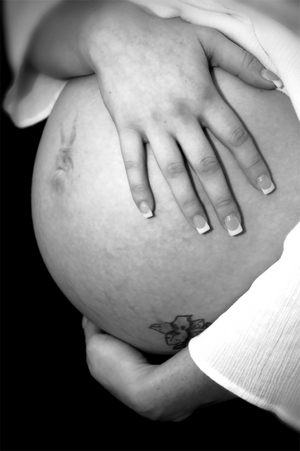Checking your cervix for dilation is absolutely not necessary and in some cases can do much more harm than good. In safe instances, however, many mothers do like to check for dilation just so that they will have an idea of what is going on “down there”.
Your cervix is a muscle which closes off the passageway between your uterus and your vagina. There is normally a small hole in the cervix which is sealed up with a plug of mucous. During labor, the hole in your cervix will begin to dilate slowly from one centimeter in width to ten centimeters in width. Once your cervix has opened up to ten centimeters, you are considered fully dilated and ready to give birth. At ten centimeters the opening is large enough for the baby’s head to pass through.
Some women like to check during labor for dilation to see how far along they are progressing. Some women like to check to see if they really are in labor or if they are just having momentary contractions. Some mothers check their dilation in labor to see if the cervix is wide enough for them to begin pushing.
There are some reasons why you might not wish to check your dilation. Checking introduces germs into the vagina, for one. If the cervix is closed or if the mother is in the pushing stage, the chances of causing an infection are very slim. On the other hand, if you are hemorrhaging, bleeding, miscarrying, or if there is a cord prolapse, checking your cervix may introduce infection into your uterus which can cause problems for you or the baby. If you do decide to do checks, make sure that your hands and the outside of your vagina are clean. You should never check for dilation if you are bleeding during pregnancy. You should also never check after your water has broken, especially if you are not yet in labor.
Another reason not to check dilation during labor is because some mothers find it distressing. When a woman has labored for a long time and checks her dilation to see if it will be over soon, she may get a feeling of desperation if she finds that she has not dilated very far. This fear or distress can cause her to tense up and clamp down and may actually have the opposite effect and make the birth longer and more difficult. There is no set time-period for how quickly the cervix will dilate, so if you check and are only four centimeters, it does not mean that your labor will be long. It’s possible that the remaining six centimeters can take a very short time to reach maximum dilation.
If you are going to be checked, it is best to do it yourself rather than let someone besides you or your partner check you. Your body is used to your germs, so infection will be unlikely. Having another person check, however, introduces new germs into your body and your chances of infection become greater.
To check dilation, insert two fingers into your vagina or have a partner do it for you. Push your fingers in gently as far as they will go. A closed cervix will feel a little like puckered lips – soft and spongy. Once the cervix dilates, you will be able to stick the tip of one finger or more inside. Using your two fingers, measure the distance from one side of the cervix to the other. Be very careful not to break the bag of waters surrounding your baby’s head.
If you are having trouble reaching around your belly, try standing with one foot up on a chair or on the toilet. Reach your fingers straight back toward your bottom. Don’t worry if you can’t feel your cervix. Some women are unable to reach and many women say that they are unable to feel their cervix at all.






